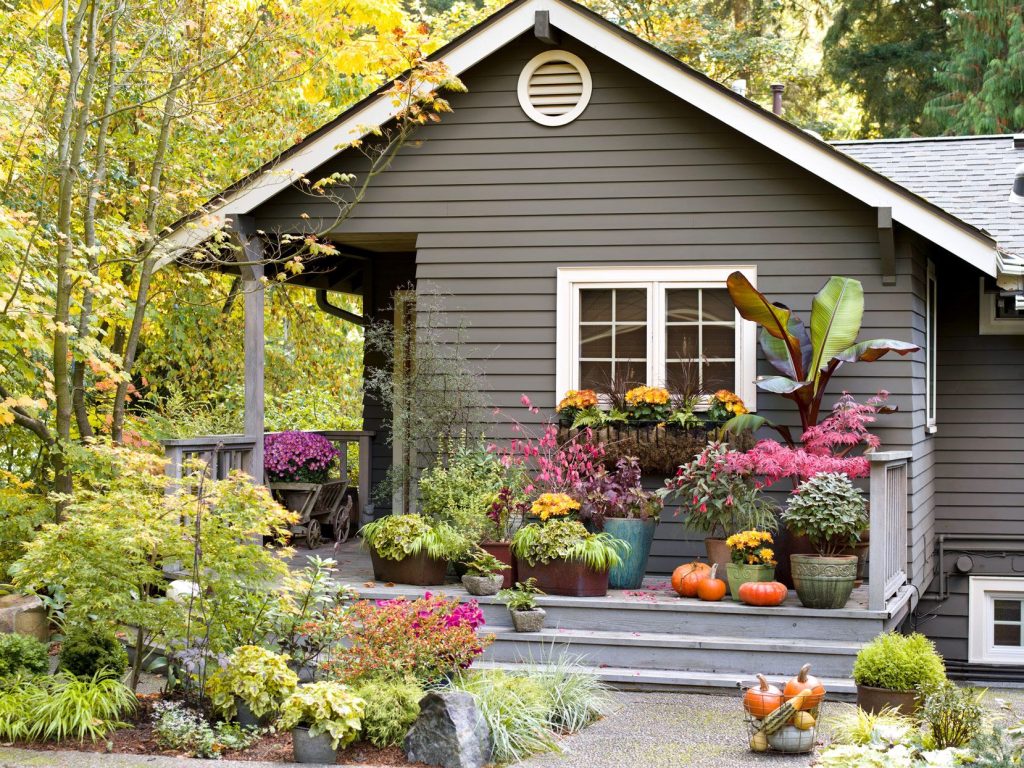:max_bytes(150000):strip_icc():format(jpeg)/home-exterior-container-garden-porch-1e9f72f4-898dedf987ad4d0e8d2ee3dfef52ee6b.jpg)
The Old Farmer’s Almanac forecasts this summer as the hottest on record, breaking the previous two years’ record-high temperatures.
And while hot weather is excellent for sun-loving plants like tomatoes and sunflowers, it can quickly dry out plants growing in containers, rather than in garden beds. Avoid a droopy fate for your container plants by following a few hot-weather watering tips.
How Often Should You Water Container Gardens?
Your watering schedule can vary depending on the type of plant and the growing conditions, but when the weather is especially hot, you’ll want to keep a close eye on your containers.
“In extreme heat, containers—especially those in full sun—may need to be watered once or even twice a day to prevent the soil from drying out completely,” says Sara Rubens, garden consultant and owner of Seed to Sanctuary. “Plants like tomatoes and other fruiting vegetables generally need more water than flowers or foliage plants, since they’re putting extra energy into producing fruit. These thirsty plants can wilt quickly in hot weather, so it’s important to keep their soil consistently moist but not soggy.”
For most containers, plan on watering at least once a day. Plants in the shade might do well with watering every other day, but in extra hot conditions, they can also dry out quickly.
“In hot summer weather, vegetable container gardens often need to be watered once, sometimes twice a day,” says Kiera Faulkner Jekos, garden designer and educator at Gardenwell. “Fruiting crops like tomatoes, cucumbers, and peppers rely on consistent moisture to thrive. When grown in pots, their root systems are relatively shallow, making them more sensitive to fluctuations.”
So When Is It Time to Water?
You might be able to use visual cues to tell when your plants need a drink, like drooping leaves and slightly brown edges, but it’s best not to let your containers dry out to that point.
“The simplest way to check if it’s time to water? Stick your finger a few inches into the soil,” Faulkner Jekos says. “It should feel cool and moist. If it’s dry at that depth, it’s time to water.”
Is It Possible to Overwater Container Gardens in Summer?
While dried-out plants might be your biggest concern this summer, it’s still possible to overwater, even in record-breaking heat. One of the biggest dangers in container gardens is a lack of drainage, which can cause your plants to sit in soggy soil.
“When soil stays saturated, roots can’t breathe, so growth stalls,” Faulkner Jekos says. “Other signs of overwatering include yellowing lower leaves and wilted plants despite wet soil.”
To prevent overwatering, check on your plants before assuming they need a drink. Use a finger to feel the soil, as Faulkner Jekos suggests. If it’s dry an inch or two down, go ahead and water. However, if the soil still feels moist, wait to water. If your plants don’t feel like they need water first thing in the morning, that could change in a few hours, especially if they’re in the sun.
Selecting the proper garden containers can also prevent overwatering and issues like root rot.
“Good drainage is also key; make sure containers have drainage holes and aren’t sitting in saucers full of standing water,” Rubens says.
How to Keep Containers Watered All Summer
It’s easy to keep up with your watering schedule when you’re at home, but summer is also the perfect time to plan a weekend getaway or weeklong vacation. Even if you don’t have someone to take over watering duties when you’re away, you don’t have to sacrifice your plants to the summer heat.
Keep Them in the Shade
First, your plants will have the best chance of survival if they aren’t in direct sunlight all day. Their soil will dry out a little more slowly in the shade, and a short break from the sun (think a few days rather than multiple weeks) shouldn’t hurt full-sun plants.
“Grouping pots in a shady spot can help reduce moisture loss, and using a thick layer of mulch on top of the soil can help retain moisture longer,” Rubens says.
Consider Self-Watering
Second, take full advantage of self-watering planters and tools. Reubens says self-watering containers, drip irrigation systems with timers, or even DIY methods like upside-down water bottles or water globes can keep plants hydrated for several days. But be sure to test your setup before you leave so you know it works.
With proper care and attention, your container gardens can thrive even in record-breaking heat this summer. Just be sure to pay attention to the dryness of the soil to know when you need to water, and plan ahead if you’ll be out of town so your plants can thrive until fall.

